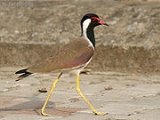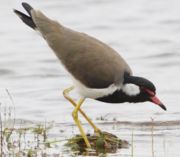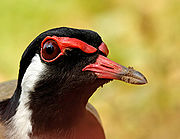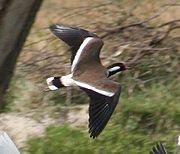
Red-wattled Lapwing
Encyclopedia
The Red-wattled Lapwing (Vanellus indicus) is a lapwing
or large plover
, a wader
in the family Charadriidae
. It has characteristic loud alarm calls which are variously rendered as did he do it or pity to do it leading to colloquial names like the did-he-do-it bird. Usually seen in pairs or small groups not far from water but may form large flocks in the non-breeding season (winter).
s, about 35cm long. The wings and back are light brown with a purple sheen, but head and chest and front part of neck are black. Prominently white patch runs between these two colours, from belly and tail, flanking the neck to the sides of crown. Short tail is tipped black. A red fleshy wattle
in front of each eye, black-tipped red bill, and the long legs are yellow. In flight, prominent white wing bars formed by the white on the secondary coverts.
 Race aigneri is slightly paler and larger than the nominate race and is found in Turkey, Iran, Iraq, Afghanistan and the Indus valley. The nominate race is found all over India. The Sri Lankan race lankae is smaller and dark while atronuchalis the race in north-eastern India and eastern Bangladesh has a white cheek surrounded by black.
Race aigneri is slightly paler and larger than the nominate race and is found in Turkey, Iran, Iraq, Afghanistan and the Indus valley. The nominate race is found all over India. The Sri Lankan race lankae is smaller and dark while atronuchalis the race in north-eastern India and eastern Bangladesh has a white cheek surrounded by black.
Males and females are similar in plumage but males have a 5% longer wing and tend to have a longer carpal spur. The length of the birds is 320-350mm, wing of 208-247mm with the nominate averaging 223mm, Sri Lanka 217mm. The Bill is 31-36mm and tarsus of 70-83mm. Tail length is 104-128mm.
It usually keeps in pairs or trios in well-watered open country, ploughed fields, grazing land, and margins and dry beds of tanks and puddles. They occasionally form large flocks, ranging from 26 to 200 birds. It is also found in forest clearings around rain-filled depressions. It runs about in short spurts and dips forward obliquely (with unflexed legs) to pick up food in a typical plover manner. They are said to feed at night being especially active around the full moon. Is uncannily and ceaselessly vigilant, day or night, and is the first to detect intrusions and raise an alarm, and was therefore considered a nuisance by hunters. Flight rather slow, with deliberate flaps, but capable of remarkable agility when defending nest or being hunted by a hawk.
Its striking appearance is supplemented by its noisy nature, with a loud and scolding did-he-do-it call, often uttered at night.
Leucistic abnormal plumage
is rare.
The local names include titeeri (Hindi), tateehar (Sindhi), titodi (Gujarati), hatatut (Kashmiri), balighora (Assamese), yennappa chitawa (Telugu), aal-kaati (Tamil, meaning "human indicator").
 It breeds from West Asia (Iraq
It breeds from West Asia (Iraq
, SW Iran
, the Arabian/Persian Gulf) eastwards across South Asia
(Baluchistan
, Afghanistan
, Pakistan
, the entire India
n subcontinent up to Kanyakumari
and up to 1800m in Kashmir
/Nepal
), with another sub-species further east in Southeast Asia
. May migrate
altitudinally in spring and autumn (e.g. in N. Baluchistan
or NW Pakistan
), and spreads out widely in the monsoons on creation of requisite habitats, but by and large the populations are resident.
This species is declining in its western range, but is abundant in much of South Asia
, being seen at almost any wetland habitat in its range.
s or flash their wings to deter any herbivores that threaten the nest. Males appear to relieve the females incubating at the nest particularly towards the hot part of noon. The eggs hatch in 28 to 30 days. The reproductive success is about 40%. Egg mortality is high (~43%) due to predation by mongooses, crows and kites. Chicks had a lower mortality (8.3%) and their survival improved after the first week.
Like other lapwings, they soak their belly feathers to provide water to their chicks as well as to cool the eggs during hot weather.
They bathe in pools of water when available and will often spend time on preening when leaving the nest or after copulation. They sometimes rest on the ground with the tarsi laid flat on the ground and at other times may rest on one leg.
 Healthy adult birds have few predators. Some species of tapeworm and trematodes have been described as endoparasites.
Healthy adult birds have few predators. Some species of tapeworm and trematodes have been described as endoparasites.
s, snail
s and other invertebrates, mostly picked from the ground. They may also feed on some grains. They feed mainly during the day but they may also feed at night. They may sometimes make use of the legs to disturb insect prey.
In parts of Rajasthan it is believed that the laying of eggs by the lapwing on high ground was an indication of good rains to come.
Lapwing
Vanellinae are any of various crested plovers, family Charadriidae, noted for its slow, irregular wingbeat in flight and a shrill, wailing cry. Its length is 10-16 inches. They are a subfamily of medium-sized wading birds which also includes the plovers and dotterels. The Vanellinae are...
or large plover
Plover
Plovers are a widely distributed group of wading birds belonging to the subfamily Charadriinae. There are about 40 species in the subfamily, most of them called "plover" or "dotterel". The closely related lapwing subfamily, Vanellinae, comprises another 20-odd species.Plovers are found throughout...
, a wader
Wader
Waders, called shorebirds in North America , are members of the order Charadriiformes, excluding the more marine web-footed seabird groups. The latter are the skuas , gulls , terns , skimmers , and auks...
in the family Charadriidae
Charadriidae
The bird family Charadriidae includes the plovers, dotterels, and lapwings, about 64 to 66 species in all.- Morphology :They are small to medium-sized birds with compact bodies, short, thick necks and long, usually pointed, wings, but most species of lapwing may have more rounded wings...
. It has characteristic loud alarm calls which are variously rendered as did he do it or pity to do it leading to colloquial names like the did-he-do-it bird. Usually seen in pairs or small groups not far from water but may form large flocks in the non-breeding season (winter).
Description
Red-wattled Lapwings are large waderWader
Waders, called shorebirds in North America , are members of the order Charadriiformes, excluding the more marine web-footed seabird groups. The latter are the skuas , gulls , terns , skimmers , and auks...
s, about 35cm long. The wings and back are light brown with a purple sheen, but head and chest and front part of neck are black. Prominently white patch runs between these two colours, from belly and tail, flanking the neck to the sides of crown. Short tail is tipped black. A red fleshy wattle
Wattle (anatomy)
A wattle is a fleshy dewlap or caruncle hanging from various parts of the head or neck in several groups of birds, goats and other animals. In some birds the caruncle is erectile tissue.The wattle is frequently an organ of sexual dimorphism...
in front of each eye, black-tipped red bill, and the long legs are yellow. In flight, prominent white wing bars formed by the white on the secondary coverts.

Males and females are similar in plumage but males have a 5% longer wing and tend to have a longer carpal spur. The length of the birds is 320-350mm, wing of 208-247mm with the nominate averaging 223mm, Sri Lanka 217mm. The Bill is 31-36mm and tarsus of 70-83mm. Tail length is 104-128mm.
It usually keeps in pairs or trios in well-watered open country, ploughed fields, grazing land, and margins and dry beds of tanks and puddles. They occasionally form large flocks, ranging from 26 to 200 birds. It is also found in forest clearings around rain-filled depressions. It runs about in short spurts and dips forward obliquely (with unflexed legs) to pick up food in a typical plover manner. They are said to feed at night being especially active around the full moon. Is uncannily and ceaselessly vigilant, day or night, and is the first to detect intrusions and raise an alarm, and was therefore considered a nuisance by hunters. Flight rather slow, with deliberate flaps, but capable of remarkable agility when defending nest or being hunted by a hawk.
Its striking appearance is supplemented by its noisy nature, with a loud and scolding did-he-do-it call, often uttered at night.
Leucistic abnormal plumage
Plumage
Plumage refers both to the layer of feathers that cover a bird and the pattern, colour, and arrangement of those feathers. The pattern and colours of plumage vary between species and subspecies and can also vary between different age classes, sexes, and season. Within species there can also be a...
is rare.
The local names include titeeri (Hindi), tateehar (Sindhi), titodi (Gujarati), hatatut (Kashmiri), balighora (Assamese), yennappa chitawa (Telugu), aal-kaati (Tamil, meaning "human indicator").
Distribution

Iraq
Iraq ; officially the Republic of Iraq is a country in Western Asia spanning most of the northwestern end of the Zagros mountain range, the eastern part of the Syrian Desert and the northern part of the Arabian Desert....
, SW Iran
Iran
Iran , officially the Islamic Republic of Iran , is a country in Southern and Western Asia. The name "Iran" has been in use natively since the Sassanian era and came into use internationally in 1935, before which the country was known to the Western world as Persia...
, the Arabian/Persian Gulf) eastwards across South Asia
South Asia
South Asia, also known as Southern Asia, is the southern region of the Asian continent, which comprises the sub-Himalayan countries and, for some authorities , also includes the adjoining countries to the west and the east...
(Baluchistan
Balochistan (region)
Balochistan or Baluchistan is an arid, mountainous region in the Iranian plateau in Southwest Asia; it includes part of southeastern Iran, western Pakistan, and southwestern Afghanistan. The area is named after the numerous Baloch tribes, Iranian peoples who moved into the area from the west...
, Afghanistan
Afghanistan
Afghanistan , officially the Islamic Republic of Afghanistan, is a landlocked country located in the centre of Asia, forming South Asia, Central Asia and the Middle East. With a population of about 29 million, it has an area of , making it the 42nd most populous and 41st largest nation in the world...
, Pakistan
Pakistan
Pakistan , officially the Islamic Republic of Pakistan is a sovereign state in South Asia. It has a coastline along the Arabian Sea and the Gulf of Oman in the south and is bordered by Afghanistan and Iran in the west, India in the east and China in the far northeast. In the north, Tajikistan...
, the entire India
India
India , officially the Republic of India , is a country in South Asia. It is the seventh-largest country by geographical area, the second-most populous country with over 1.2 billion people, and the most populous democracy in the world...
n subcontinent up to Kanyakumari
Kanyakumari District
Kanyakumari District ) is a district of Tamil Nadu state, India and is the southernmost land area of mainland India.The district is the second most urbanised district in Tamilnadu, next only to Chennai and ahead of Coimbatore. It also has the highest literacy and education levels in the...
and up to 1800m in Kashmir
Kashmir
Kashmir is the northwestern region of the Indian subcontinent. Until the mid-19th century, the term Kashmir geographically denoted only the valley between the Great Himalayas and the Pir Panjal mountain range...
/Nepal
Nepal
Nepal , officially the Federal Democratic Republic of Nepal, is a landlocked sovereign state located in South Asia. It is located in the Himalayas and bordered to the north by the People's Republic of China, and to the south, east, and west by the Republic of India...
), with another sub-species further east in Southeast Asia
Southeast Asia
Southeast Asia, South-East Asia, South East Asia or Southeastern Asia is a subregion of Asia, consisting of the countries that are geographically south of China, east of India, west of New Guinea and north of Australia. The region lies on the intersection of geological plates, with heavy seismic...
. May migrate
Bird migration
Bird migration is the regular seasonal journey undertaken by many species of birds. Bird movements include those made in response to changes in food availability, habitat or weather. Sometimes, journeys are not termed "true migration" because they are irregular or in only one direction...
altitudinally in spring and autumn (e.g. in N. Baluchistan
Balochistan (region)
Balochistan or Baluchistan is an arid, mountainous region in the Iranian plateau in Southwest Asia; it includes part of southeastern Iran, western Pakistan, and southwestern Afghanistan. The area is named after the numerous Baloch tribes, Iranian peoples who moved into the area from the west...
or NW Pakistan
Pakistan
Pakistan , officially the Islamic Republic of Pakistan is a sovereign state in South Asia. It has a coastline along the Arabian Sea and the Gulf of Oman in the south and is bordered by Afghanistan and Iran in the west, India in the east and China in the far northeast. In the north, Tajikistan...
), and spreads out widely in the monsoons on creation of requisite habitats, but by and large the populations are resident.
This species is declining in its western range, but is abundant in much of South Asia
South Asia
South Asia, also known as Southern Asia, is the southern region of the Asian continent, which comprises the sub-Himalayan countries and, for some authorities , also includes the adjoining countries to the west and the east...
, being seen at almost any wetland habitat in its range.
Behaviour and ecology
The breeding season is mainly March to August. The courtship involves the male puffing its feathers and pointing its beak upwards. The male then shuffles around the female. Several males may display to females and they may be close together. The eggs are laid in a ground scrape or depression sometimes fringed with pebbles, goat or hare droppings. About 3-4 black-blotched buff eggs shaped a bit like a peg-top (pyriform), 42x30 mm on average. Nests are difficult to find since the eggs are cryptically coloured and usually matches the ground pattern. In residential areas, they sometimes take to nesting on roof-tops. They have been recorded nesting on the stones between the rails of a railway track, the adult leaving the nest when trains passed. Nests that have been threatened by agricultural operations have been manually translocated by gradually shifting the eggs. When nesting they will attempt to dive bomb or distract potential predators. Both the male and female incubate the eggs and divert predators using distraction displayDistraction display
Distraction displays, also known as deflection display, diversionary display or paratrepsis, are anti-predator behaviours used to attract the attention of an enemy away from an object, typically the nest or young, that is being protected. They are particularly well known in birds but noted also in...
s or flash their wings to deter any herbivores that threaten the nest. Males appear to relieve the females incubating at the nest particularly towards the hot part of noon. The eggs hatch in 28 to 30 days. The reproductive success is about 40%. Egg mortality is high (~43%) due to predation by mongooses, crows and kites. Chicks had a lower mortality (8.3%) and their survival improved after the first week.
Like other lapwings, they soak their belly feathers to provide water to their chicks as well as to cool the eggs during hot weather.
They bathe in pools of water when available and will often spend time on preening when leaving the nest or after copulation. They sometimes rest on the ground with the tarsi laid flat on the ground and at other times may rest on one leg.

Diet
The diet of the lapwing includes a range of insectInsect
Insects are a class of living creatures within the arthropods that have a chitinous exoskeleton, a three-part body , three pairs of jointed legs, compound eyes, and two antennae...
s, snail
Snail
Snail is a common name applied to most of the members of the molluscan class Gastropoda that have coiled shells in the adult stage. When the word is used in its most general sense, it includes sea snails, land snails and freshwater snails. The word snail without any qualifier is however more often...
s and other invertebrates, mostly picked from the ground. They may also feed on some grains. They feed mainly during the day but they may also feed at night. They may sometimes make use of the legs to disturb insect prey.
In culture
The eggs are often collected by people and used in traditional remedies for asthma and typhoid. In parts of India, a local belief is that the bird sleeps on its back with the legs upwards and an associated Hindi metaphor Tithiri se asman thama jaega ("can the pee-wit support the heavens?") is used when referring to persons undertaking tasks beyond their ability or strength.In parts of Rajasthan it is believed that the laying of eggs by the lapwing on high ground was an indication of good rains to come.
Other sources
- Anon. (1991) Flocking of Red Wattled Lapwings. Newsletter for BirdwatchersNewsletter for BirdwatchersNewsletter for Birdwatchers is an Indian periodical of ornithology and birdwatching founded in 1960 by Zafar Futehally, who edited it until 2003. It was initially mimeographed and distributed to a small number of subscribers each month. The editorial board in its early years included Salim Ali,...
31(5-6):1. - Dharmakumarsinhji,RS (1965) Small displacement by ground nesting birds. Newsletter for BirdwatchersNewsletter for BirdwatchersNewsletter for Birdwatchers is an Indian periodical of ornithology and birdwatching founded in 1960 by Zafar Futehally, who edited it until 2003. It was initially mimeographed and distributed to a small number of subscribers each month. The editorial board in its early years included Salim Ali,...
5(9):10. - Jamdar,Nitin (1985) Redwattled Lapwing (Vanellus indicus) suffering from cataract. J. Bombay Nat. Hist. Soc. 82(1):197.
- Kalsi,RS; Khera,S (1986) Some observations on breeding and displacement behaviour of the Redwattled Lapwing Vanellus indicus indicus (Aves: Charadriidae). Res. Bull. Panjab Univ. 37:131-141.
- Khajuria,H (1972) Nestlings of the redwattled lapwing, Vanellus i. indicus (boddaert). Pavo 8(1&2):82-83.
- Koshy,MS (1989) Lapwings on a roof. Newsletter for BirdwatchersNewsletter for BirdwatchersNewsletter for Birdwatchers is an Indian periodical of ornithology and birdwatching founded in 1960 by Zafar Futehally, who edited it until 2003. It was initially mimeographed and distributed to a small number of subscribers each month. The editorial board in its early years included Salim Ali,...
29(7-8):7. - Krishnan, M (1998) Ubiquitous alarmist. Blackbuck. 14(3&4):88-90.
- Jackson,P (1976) Redwattled Lapwing. Newsletter for BirdwatchersNewsletter for BirdwatchersNewsletter for Birdwatchers is an Indian periodical of ornithology and birdwatching founded in 1960 by Zafar Futehally, who edited it until 2003. It was initially mimeographed and distributed to a small number of subscribers each month. The editorial board in its early years included Salim Ali,...
16(3):11-12. - Saxena,VS (1973) Unusual nesting by Redwattled Lapwing. Indian Forester 99:33-35.

